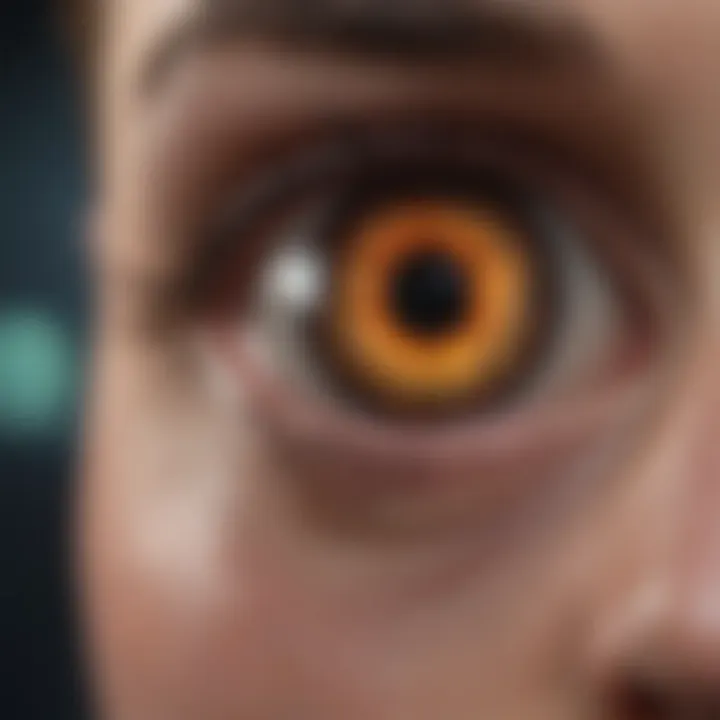Exploring Toric Lens Technology and Its Impact


Intro
Toric lens technology stands at the forefront of advancements in vision correction, particularly for individuals diagnosed with astigmatism. This article aims to provide a comprehensive exploration of toric lenses, emphasizing their role in enhancing visual clarity. By understanding the intricacies of this technology, readers can appreciate the significance of these lenses in the broader context of optical health.
Understanding astigmatism is crucial in contextualizing toric lens applications. Astigmatism occurs when the cornea is irregularly shaped, disrupting the light entering the eye and leading to blurred vision. Toric lenses are specifically designed to address this curvature, offering a tailored solution. As technology progresses, toric lenses evolve to include cutting-edge features that facilitate improved performance and patient outcomes.
Research Overview
Key Findings
Research reveals that toric lenses significantly enhance visual acuity for astigmatic patients. Recent studies confirm that patients opting for these lenses experience a marked improvement in their quality of vision compared to traditional spherical lenses. The importance of personalized fitting and customization has also been underscored, tailoring the lens design to meet individual cornea shapes and refractive errors.
Study Methodology
Various research methodologies have been employed to assess the effectiveness of toric lenses. Clinical trials often compare the performance of toric lenses against standard lenses among diverse patient populations. Data collection methods typically involve surveys and objective measurements of visual acuity post-application, ensuring a comprehensive understanding of patient outcomes.
Background and Context
Historical Background
The development of toric lenses traces back to advancements in optical science in the late 19th century. Initial designs primarily focused on correcting spherical aberrations. However, as understanding of astigmatism improved, targeted designs emerged. Over the decades, manufacturing techniques have advanced, leading to the production of high-quality, customizable toric lenses suited for various patients.
Current Trends in the Field
Currently, the field of toric lens technology is witnessing rapid developments. Innovations such as hybrid materials and advanced surgical techniques enhance both performance and comfort. Increased awareness of astigmatism and the growing focus on personalized vision correction further propel these trends. Industry leaders continue to invest in research, indicating a promising future for toric lens advancements.
"Toric lenses are a critical innovation in the correction of astigmatism, offering patients clearer and more comfortable vision."
In summation, the exploration of toric lens technology reveals its profound implications for vision correction. Understanding its functionality and ongoing developments provides valuable insights for students, researchers, and professionals alike. As we delve deeper into the subject, ongoing advancements will further illuminate the path toward effective ocular health solutions.
Preface to Toric Lenses
Toric lenses stand as a pivotal innovation in the realm of vision correction, particularly for those afflited by astigmatism. Understanding this technology is essential to comprehend its role in improved visual outcomes and the quality of life for millions. These lenses are specifically designed to address the irregular curvature of the cornea or lens, which is characteristic of astigmatism. This section serves as an entry point into the broader discussions surrounding toric lenses, elucidating their definition, purpose, and historical context that has shaped their development.
Definition and Purpose
Toric lenses are a specialized type of corrective lens. They differ from standard spherical lenses by having a varied optical power in different meridians of the lens. This design aims to compensate for the uneven focusing that occurs in individuals with astigmatism. In practical terms, these lenses allow for clearer vision by aligning with the specific curvature of the eye, thus providing a more accurate focus of light on the retina.
The primary purpose of toric lenses is to correct astigmatism, which can lead to blurred vision, distortion, and other visual impairments. Their unique shape helps in stabilizing the lens on the eye, which is vital for achieving optimal vision correction. Patients may use toric lenses in various forms, including soft contact lenses, rigid gas permeable lenses, and intraocular lenses surgically implanted during procedures like cataract surgery.
Beyond simple correction, the use of toric lenses brings enhanced comfort and clarity for users. They can engage more fully in daily activities without the visual disruptions caused by astigmatism. This dual function of correction and user comfort underscores the importance of toric lenses in ophthalmic practice.
Historical Development
The journey of toric lens technology is marked by significant milestones that reflect advancements in optics and materials science. The concept of correcting astigmatism with lenses dates back to the late 19th century when the first cylindrical lenses were developed. These initial lenses were not widely adopted due to manufacturing limitations and the complexities associated with fitting them onto the patient’s eye shape.
In the mid-20th century, advancements in materials technology led to the development of soft contact lenses. These lenses were more comfortable and feasible for everyday use, paving the way for the introduction of soft toric lenses in the 1970s. The first commercially successful toric contact lens was launched, changing how patients with astigmatism could correct their vision.
Today, toric lenses continue to evolve with innovations in design and materials. Utilization of digital mapping techniques for fitting and the introduction of new materials with improved biocompatibility have streamlined their use. As awareness and demand for effective astigmatism correction grow, further advancements are likely in both surgical and non-surgical options for providing clear vision.
Understanding Astigmatism
Understanding astigmatism is central to this article as it provides the necessary context for the development and application of toric lens technology. Astigmatism is a common refractive error that occurs when the cornea or lens of the eye is irregularly shaped. This irregularity prevents light from focusing sharply on the retina, leading to blurred or distorted vision. By comprehending the mechanics of astigmatism, one can better appreciate how toric lenses are designed to correct these specific visual impairments.
Astigmatism often occurs in conjunction with other refractive errors, such as myopia or hyperopia. It is classified broadly based on its primary orientation and degree. This classification is crucial because it guides the selection of suitable optical devices for correction. Conditions like these necessitate tools like toric lenses, underscoring their importance in modern optometry.
Types of Astigmatism
Astigmatism can be categorized into several types, each defined by the alignment of the corneal curvature relative to the horizontal or vertical axis. The three primary types include:
- Regular Astigmatism: This is the most common form. The meridians (the lines of curvature) are perpendicular to each other. Regular astigmatism can be either:
- Irregular Astigmatism: This occurs when the cornea has an uneven or asymmetrical shape, causing distorted vision that can’t be corrected by simple glasses or standard contact lenses. Causes can include keratoconus, scar tissue from surgery, or trauma.
- Combined Astigmatism: This form features both regular and irregular components, resulting in complex visual distortions. Understanding these types is vital, as each may require different corrective strategies.
- Myopic: Where the curvature is steeper in the vertical meridian, leading to difficulty seeing distant objects.
- Hyperopic: Where the curvature is steeper in the horizontal meridian, causing problems with near vision.
Symptoms and Diagnosis
The symptoms of astigmatism frequently include:
- Blurred or distorted vision at all distances.
- Difficulty seeing at night.
- Eye strain or discomfort after prolonged reading or computer work.
- Frequent headaches.
The diagnosis of astigmatism is conducted through a comprehensive vision exam. During this exam, several tests may be performed:
- Visual Acuity Test: Determines how well you can see at various distances.
- Keratometry: Measures the curvature of the cornea.
- Refraction Test: Determines the lens prescription needed for clear vision.
"Early diagnosis of astigmatism is crucial to prevent long-term visual complications."
Accurate diagnosis enables eye care professionals to recommend effective treatment options, such as toric lenses, which are specifically designed to address the unique requirements of astigmatism.
Types of Toric Lenses
The realm of toric lenses is multifaceted, encompassing various types tailored to address specific vision correction needs. Understanding the diverse types of toric lenses is crucial in this article, as it allows us to explore their unique characteristics, benefits, and considerations. Each type has distinct features that cater to different patient requirements, enhancing the overall efficacy of vision correction strategies.
Soft Toric Lenses
Soft toric lenses are among the most common options for correcting astigmatism. They are made of soft, flexible materials, making them comfortable for extended wear. The curvature of these lenses is specifically designed to counteract the irregular shape of the cornea found in astigmatic eyes. One of the key benefits of soft toric lenses is their availability in both daily and extended wear formats.
"Soft toric lenses adjust to the shape of your eye, providing improved comfort and vision."
However, fit is essential. An ill-fitting lens can lead to complications such as blurred vision or discomfort. A proper fitting process involves extensive measurements of the eye's surface, which ensures that the lens will be adequately aligned to provide optimal visual clarity. Moreover, patients often require a period of adaptation, and regular follow-up visits are necessary to confirm the lens is functioning correctly.
Rigid Gas Permeable Toric Lenses


Rigid gas permeable (RGP) toric lenses offer benefits that differ from those of soft lenses. Made from durable plastic, RGP lenses allow oxygen to pass through to the eye, which can be beneficial for eye health. These lenses can provide sharper vision in some cases due to their stiffness, allowing them to retain their shape better than soft lenses.
RGP toric lenses generally have a longer lifespan than soft lenses. This means that, while the initial investment may be higher, the long-term cost may balance out favorably. However, they may require a longer acclimatization period for new users.
Users should also be aware that RGP lenses may not be suitable for all patients, especially those with irregular corneal shapes or unique fitting needs. Thus, a thorough evaluation by an eye care professional is vital.
Toric Intraocular Lenses
Toric intraocular lenses (IOLs) are a specific innovation in lens technology, used primarily in cataract surgery. These lenses are inserted into the eye during surgery to replace the eye's natural lens that has become clouded. The distinctive feature of toric IOLs is that they are shaped to correct astigmatism, allowing for clearer vision post-surgery.
One of the strong points of toric IOLs is that they provide a long-term solution to vision correction. Once implanted, they can significantly reduce the dependency on glasses or contact lenses for patients with astigmatism. It is essential, though, that these lenses are accurately positioned during surgery to ensure optimal results. A careful alignment process is crucial, as even minor misalignment can lead to less effective vision correction.
The Mechanics of Toric Lenses
Understanding the mechanics of toric lenses is vital for grasping how they provide effective solutions for vision correction, particularly for astigmatism. The interplay of design elements and fitting procedures ensures optimal performance and comfort. By focusing on these aspects, we can appreciate the complexities involved in lens technology and their practical application.
Optical Design Principles
Toric lenses are uniquely designed to correct astigmatism, which means their optical properties differ based on the principal meridians. The curvature of the lens varies, allowing it to focus light more effectively. This feature is essential in providing clearer vision since astigmatism often leads to blurred or distorted sight.
Key principles in the optical design of toric lenses include:
- Base Curve: This is the spherical component that rests on the eye and plays a role in the overall fitting.
- Cylinder Power: It corrects the uneven focusing caused by astigmatism. The measurement is determined based on the specific requirements of the patient's eye.
- Axis: This refers to the orientation of the cylinder power, which must align with the astigmatism's orientation for effective correction.
"The design of toric lenses not only seeks to correct vision but also to enhance the overall experience of seeing clearly while wearing lenses."
Each element must be meticulously calculated to ensure that the lens functions effectively and fits comfortably. Thus, understanding these principles is crucial for both eye care professionals and patients alike.
Fitting and Alignment
The fitting of toric lenses requires a precise approach, given their specific optical characteristics. Improper alignment can lead to poor visual outcomes and discomfort. The fitting process involves several steps:
- Initial Assessment: An evaluation of the patient's eye measurements, including corneal curvature and astigmatism degree, is conducted to ensure compatibility with toric lenses.
- Trial Lenses: Eye care professionals often use trial lenses to determine the best fit. This step allows adjustments in curvature and orientation before prescribing a final lens.
- Monitoring Rotation: It is essential to monitor how the lens behaves on the eye. Toric lenses can rotate slightly, which can affect vision if not corrected. Regular feedback from the patient helps in making necessary adjustments.
Weighing all these considerations is fundamental. The precision in fitting and alignment can significantly impact the effectiveness of the lens, resulting in better patient satisfaction and overall vision quality.
Indications for Toric Lens Use
Toric lenses serve a critical role in the treatment of astigmatism, providing a tailored approach to vision correction. Their unique design accommodates the specific curvature of the cornea or lens, allowing for more precise light refraction. Understanding when to use toric lenses is important for both practitioners and patients, as it can significantly impact visual outcomes and overall satisfaction.
Patient Selection Criteria
The selection of patients for toric lens use is complex and requires a thorough evaluation. Certain criteria must be met to ensure the best possible results. Here are some key considerations:
- Degree of Astigmatism: Patients with moderate to high astigmatism are typically better candidates for toric lenses, as they provide the necessary correction for more significant refractive errors.
- Corneal Topography: A detailed mapping of the cornea is essential. Irregularities can affect the effectiveness of toric lenses, so practitioners often perform topography tests before fitting.
- Previous Surgery History: Patients with a history of eye surgeries may have different needs. Their prior surgeries could influence the decisions regarding toric lens use.
- Lifestyle and Occupational Needs: Patients with specific visual demands from their jobs or hobbies must be considered when selecting correct lenses. Active individuals often benefit from the stability and clarity provided by toric options.
A comprehensive examination and open communication with patients about their visual needs and expectations are vital in this selection process.
Common Conditions Treated
Toric lenses are effective in treating a range of conditions related to astigmatism. Some common conditions include:
- Regular Astigmatism: Resulting from an uneven curvature of the cornea or lens, this condition is the primary indication for toric lens use.
- Irregular Astigmatism: Often caused by keratoconus or post-surgical changes, this type may require specialized toric lenses or hybrid designs.
- Post-Cataract Surgery: Many patients experience residual astigmatism after cataract surgery, where toric intraocular lenses can be beneficial.
- Anisometropia: Significant differences in refractive power between the two eyes can also be addressed with toric lenses.
Utilizing toric lenses can lead to improved visual outcomes and enhance the quality of life for patients by providing clearer and more comfortable vision. Given their specific design features, practitioners can achieve effective results through careful patient selection and personalized fitting.
Surgical Options for Toric Lenses
Toric lenses play a crucial role in the surgical correction of astigmatism. It is important to consider the surgical options available for these lenses, as they offer a viable solution for patients with this common vision condition. Understanding these options highlights how they can enhance visual outcomes and patient quality of life. This section discusses two primary surgical approaches: cataract surgery with toric lenses and refractive surgery. Each method has distinct benefits and considerations that patients and healthcare providers should weigh.
Cataract Surgery with Toric Lenses
Cataract surgery is one of the most routine operations in ophthalmology, and integrating toric lenses into this procedure has transformed astigmatism management. During the surgery, the cataractous lens is replaced with an artificial intraocular lens (IOL) designed to correct astigmatism specifically. This integration significantly improves post-operative visual acuity for patients suffering from both cataracts and astigmatism.
The use of toric IOLs can lead to a few important advantages:
- Enhanced Visual Acuity: Patients often experience sharper vision post-surgery. The lens design optimally reduces astigmatism, which may lead to a clearer field of vision.
- Reduced Dependence on Glasses: Many patients find they need less refractive correction after surgery, enhancing their daily life and activity participation.
- Simplified Surgical Procedure: The surgical process remains straightforward, despite the complexity of combining cataract removal with astigmatism correction.
However, there are also considerations to keep in mind. Proper alignment of the toric lens is critical for achieving desired results. Misalignment may lead to suboptimal visual outcomes. Furthermore, selection of suitable candidates based on astigmatism magnitude and visual demands is crucial. Each patient must undergo careful evaluation to ensure that cataract surgery with a toric lens is appropriate for their condition.
Refractive Surgery
Refractive surgery, including procedures like LASIK and PRK, provides another avenue for correcting astigmatism. The goal of these surgeries is to reshape the cornea to improve how light focuses on the retina. In cases of astigmatism, this reshaping helps to establish a more uniform corneal surface.
Toric refractive treatments are distinct from traditional techniques because they focus specifically on astigmatism correction. Key benefits of toric refractive surgery include:
- Precision in Correction: Advanced technologies harness precise measurements of corneal topography to tailor the surgery for individual needs.
- High Patient Satisfaction: Many patients report excellent visual outcomes and fellow satisfaction post-procedure, enhancing overall quality of life.
- Minimally Invasive: The procedures are typically outpatient with relatively quick recovery times.
Still, there are considerations for patients to address. Pre-operative assessments regarding corneal thickness and mapping are essential. Patients with higher levels of astigmatism may not be suitable for standard laser options and may require specialized approaches. Moreover, patients must be aware of potential complications, such as undercorrection or overcorrection, which may affect the results.
Post-Operative Care and Follow-Up
Post-operative care is critical in ensuring optimal outcomes for patients who have undergone procedures involving toric lenses. This phase not only emphasizes the healing process but also addresses any potential complications that may arise post-surgery. Correct management during this time can significantly improve the overall effectiveness of the lens and the patient's satisfaction with their vision correction.
Monitoring and Complications
Monitoring the patient’s progress after surgery is essential. It involves regular follow-up appointments where the eye doctor assesses the health of the eyes and the position and effectiveness of the toric lenses. This practice helps identify early signs of complications such as:
- Inflammation: Some patients may experience irritation and swelling in the eye.
- Lens Dislocation: It is possible for a lens to shift from its intended position, particularly with toric lenses, where precise alignment is crucial.
- Visual Disturbances: Patients may report issues such as blurry vision or halos around lights, which need timely evaluation.
Addressing these complications promptly can prevent long-term visual impairment and help maintain the desired level of visual acuity. Regular monitoring also allows for adjustments or interventions, such as refitting the lenses, if necessary.


Long-Term Outcomes
The long-term outcomes of using toric lenses are generally positive but depend heavily on the post-operative care provided. Studies indicate that proper follow-up can lead to lasting improvements in visual acuity and overall patient satisfaction.
Several factors contribute to good long-term outcomes:
- Adherence to Follow-Up Appointments: Patients who commit to attending follow-up visits typically experience better results.
- Post-Operative Recommendations: Instructions from eye care professionals regarding activities, medication use, and any restrictions must be followed closely.
- Patient Education and Awareness: Empowering patients to understand signs of complications can lead to quicker problem recognition and resolution.
Through diligent follow-up care and monitoring, patients are more likely to experience a successful integration of toric lenses, resulting in a significant improvement in their daily lives.
"Effective monitoring post-surgery is not just about correcting problems; it’s about fostering an environment for the patient’s recovery and adjustment to toric lenses."
In summary, post-operative care and follow-up play a crucial role in ensuring the success of toric lenses in correcting vision. The focus remains on monitoring complications and optimizing long-term outcomes, ultimately leading to enhanced patient quality of life.
Technological Advances in Toric Lens Design
The field of toric lens design has seen significant advancements in recent years. These improvements play a crucial role in enhancing the effectiveness and comfort of toric lenses for individuals experiencing astigmatism. Innovations in technology contribute to better visual outcomes and patient satisfaction. In this section, we will delve into two primary aspects of these advancements: Digital Lens Mapping and New Materials and Coatings.
Digital Lens Mapping
Digital lens mapping represents a pivotal step in the customization of toric lenses. It involves the use of sophisticated technology to accurately measure the corneal surface. Advanced optical devices create detailed maps of a patient’s eye, capturing intricate topographical data.
The benefits of digital lens mapping are manifold. It enables eye care professionals to prescribe lenses tailored to the specific contours of each patient's eye. As a result, patients often report improved clarity of vision as well as enhanced comfort when wearing their lenses. This individualization addresses the unique challenges posed by varying degrees of astigmatism, thus potentially reducing common issues like lens rotation or misalignment.
Additionally, this technology facilitates better fitting and selection of toric lenses, ensuring that they provide optimal correction for astigmatism. The precise measurements derived from digital mapping allow for adjustments in lens design that can cater to different degrees of refractive error. Ultimately, this innovation enhances the overall satisfaction and effectiveness of toric lenses in correcting vision.
New Materials and Coatings
Advancements in materials and coatings used in toric lens production have also transformed the landscape. Manufacturers are increasingly utilizing high-performance materials that offer both comfort and stability. These advanced materials are designed to be more breathable, reducing the risk of discomfort during extended wear periods.
Moreover, innovative coatings have been developed to enhance the performance of lenses. For instance, anti-reflective coatings minimize glare, improving visual acuity in various lighting conditions. Hydrophobic coatings contribute to a more comfortable experience by repelling moisture and preventing dryness, which can be a common concern for wearers.
Choosing lenses made from new materials not only impacts the longevity of the lenses but also influences visual clarity. Patients benefit from a reduced likelihood of contacting lens deposits, which can interfere with vision quality.
Challenges and Limitations of Toric Lenses
The integration of toric lenses in vision correction has brought fruitful advancements, yet challenges and limitations persist. It is essential to understand these obstacles to make informed decisions regarding the use of toric lenses in clinical practice. This section provides insights into two significant areas: patient compliance and cost considerations.
Patient Compliance
Patient compliance is a crucial aspect of effective treatment with toric lenses. While these lenses are designed to improve vision for those with astigmatism, their success heavily relies on the patient's willingness and ability to follow prescribed wearing schedules and cleaning protocols. Non-compliance can lead to suboptimal visual outcomes and increased risk of complications, including infections.
Research indicates that many patients may not fully understand the importance of adhering to wearing schedules, especially if they transition from standard lenses. Education is key to improving compliance. Patients must be made aware of the specific requirements of toric lenses, including regular replacement and proper maintenance. This can help mitigate the risks associated with prolonged wear, such as lens discomfort or reduced oxygen transmission.
Here are some strategies to enhance patient compliance:
- Education on usage and care: Provide comprehensive instructions to patients on how to wear and care for their toric lenses.
- Follow-up appointments: Regular check-ins can reinforce adherence and allow for any necessary adjustments in their treatment plan.
- Technology integration: Utilizing reminders via mobile apps can help patients keep track of their lens care routines.
"Successful patient compliance is not only about instructions but also about understanding the implications of improper use."
Cost Considerations
Cost remains a significant limitation for many potential candidates considering toric lenses. Compared to standard lenses, toric lenses often have a higher price point due to their complex design and production processes. This difference in cost can create barriers for patients, particularly those without insurance coverage that includes specific vision correction procedures.
When discussing cost considerations, it is important to look at both direct and indirect expenses:
- Direct costs: These include the price of toric lenses, which can vary widely based on brand and material.
- Indirect costs: Patients may incur additional expenses related to follow-up visits or complications arising from improper use of the lenses.
Healthcare providers should communicate the long-term benefits of investing in toric lenses despite the initial costs. Importantly, patients with astigmatism may experience improved quality of life and visual performance that can justify the expenditure over time.
In summary, while toric lenses present many advantages in treating astigmatism, challenges exist related to patient compliance and cost. Addressing these challenges through education and discussion can improve the overall efficacy of toric lens treatment for patients.
Future Trends in Toric Lens Technology
The realm of toric lens technology is constantly evolving. As advancements in materials and methodologies emerge, the future looks promising for enhancing vision correction, particularly for individuals with astigmatism. Exploring future trends in this field allows for a comprehensive understanding of potential improvements in patient care and outcomes.
Research Directions
Current research in toric lens technology focuses on various key areas. One of the most significant aspects includes improving lens design through better customization techniques. This entails refining digital mapping solutions that allow eye care professionals to create lens shapes tailored to a patient's specific corneal curvature.
Moreover, ongoing studies seek to explore the compatibility of toric lenses with other vision correction procedures. A pertinent area of inquiry is the integration of toric elements into multifocal lenses, providing combined correction for presbyopia and astigmatism. Researchers are also evaluating the long-term performance of novel materials that enhance comfort and vision clarity.
The development of artificial intelligence and machine learning platforms can facilitate precise fitting protocols. This may lead to increasing the success rate of toric lens applications, ensuring patients experience better visual outcomes.
Potential Innovations
Several potential innovations could reshape the future landscape of toric lenses. One area of focus is the introduction of new materials that combine flexibility and breathability. Advanced silicone hydrogel materials are being studied for their ability to improve oxygen permeability, possibly providing greater comfort for extended wear.
Another important trend is the enhancement of surgical procedures involving toric lenses. For example, advancements in femtosecond laser technology may allow for more precise incisions and placements of toric intraocular lenses. This precision can lead to improved surgical outcomes and patient satisfaction.
Additionally, there is potential for digital platforms to revolutionize the way patients interact with their vision correction options. Tools that provide virtual simulations of visual outcomes post-lens fitting could empower patients by helping them make informed choices regarding their eye care.
"Understanding the future trends in toric lens technology is paramount for adapting to evolving patient needs and enhancing the effectiveness of treatments."
Ultimately, the fusion of research and innovation will significantly advance toric lens technology, opening new avenues for effective vision correction.
Comparative Analysis of Toric vs. Standard Lenses
Understanding the distinctions between toric and standard lenses is crucial for many reasons. The primary factor lies in their function. Toric lenses are specifically designed to correct astigmatism, which is not the case for standard spherical lenses. This comparative analysis will delve into visual outcomes, patient satisfaction, and other relevant considerations that can inform the decision-making process for patients and practitioners alike.
Visual Outcomes


When evaluating visual outcomes, toric lenses often yield superior clarity for individuals with astigmatism. Standard lenses do not account for the irregular shape of the cornea associated with this condition, possibly leading to blurred or distorted vision. Research indicates that those who transition to toric lenses frequently report noticeable improvements in vision quality. For instance, tasks that require sharp focus, such as reading or using digital devices, become easier for patients wearing toric lenses.
Additionally, the optical design of toric lenses incorporates different powers across different meridians, which is essential for effective astigmatism correction. Comparison studies have shown that not only do toric lenses provide better visual acuity, but they also help in achieving greater contrast sensitivity. This detail is significant when considering real-world applications where light conditions vary.
"The precise design of toric lenses accommodates astigmatism effectively, ensuring that patients experience improved visual outcomes compared to standard lenses."
Patient Satisfaction
Patient satisfaction is a vital metric when analyzing the performance of toric versus standard lenses. Many users report increased comfort with toric lenses due to their tailored design. While the initial adjustment period can differ among individuals, the overall feedback tends to lean toward preference for toric lenses longer-term, especially among those with moderate to high astigmatism.
Surveys and studies also indicate that users of toric lenses often feel more satisfied with their daily activities. This is majorly due to the enhanced visual clarity which allows for better engagement in varied tasks. Furthermore, the added comfort many patients experience contributes to a positive perception of their eyecare solutions.
Regulatory Framework for Toric Lenses
The regulatory framework surrounding toric lenses is essential in ensuring patient safety and enhancing the efficacy of vision correction solutions. Regulatory agencies worldwide set stringent standards and guidelines for the design, testing, and distribution of toric lenses to maintain high quality and effectiveness. Compliance with these regulations promotes public confidence and helps clinicians make informed decisions when selecting lenses for patients with astigmatism.
Governments and health authorities focus on specific elements of regulation. These include clinical trials, manufacturing processes, and post-market surveillance. Such measures are vital in identifying potential risks associated with lens use, thereby minimizing complications and improving overall patient outcomes. Understanding the regulatory framework can assist healthcare professionals and researchers in navigating compliance requirements, ultimately fostering advancements in toric lens technology.
Global Standards and Approvals
Global standards for toric lenses encompass various criteria established by organizations like the International Organization for Standardization (ISO) and the Food and Drug Administration (FDA) in the United States. Approval processes require that lens manufacturers submit detailed documentation, including clinical data that demonstrates safety and effectiveness. Such evaluations include:
- Biocompatibility: Lenses must be safe for contact with human tissue.
- Optical Performance: Lenses should meet defined standards for visual acuity.
- Manufacturing Quality: Stringent protocols ensure lenses are produced consistently.
Achieving global approval is not just about compliance; it signals to healthcare providers and patients that a given product meets rigorous standards for performance and safety.
"Regulatory approval ensures that toric lenses not only meet design expectations but also align with safety standards relevant to public health."
Quality Control Measures
Quality control measures play a pivotal role in the manufacturing and distribution of toric lenses. Manufacturers implement ongoing evaluations at every stage, from material selection to final product testing. Quality control processes often include:
- Material Testing: Evaluating the properties of lens materials to ensure they will not irritate the eye.
- Process Validation: Verifying that manufacturing processes consistently yield products meeting specifications.
- Final Inspection: Checking for defects or inconsistencies in the finished lenses.
Such measures are crucial for identifying weaknesses in the manufacturing process that could jeopardize patient health or the lens's optical performance. Additionally, regular audits and inspections conducted by regulatory bodies further ensure adherence to established standards, fostering trust in toric lens technologies among practitioners and patients alike.
Case Studies in Toric Lens Application
Case studies play an important role in understanding the real-world effectiveness of toric lenses. They provide valuable insights into various outcomes from clinical practice that enhance our knowledge of patient experiences. These examples shed light on both successful applications and the challenges faced in implementing toric lens technology.
Successful Outcomes
Successful outcomes from case studies reflect the positive impact toric lenses have on patients with astigmatism. In several documented cases, patients who received toric lenses report significant improvements in visual clarity and overall satisfaction. For instance, a study involving post-operative cataract patients showed that those who received toric intraocular lenses had a substantial decline in astigmatism, leading to enhanced quality of life. Here are some key benefits observed:
- Improved Visual Acuity: Many patients experience sharper vision without needing additional corrective eyewear.
- Reduction of Symptoms: Symptoms such as blurred vision and eye strain significantly decrease for many users.
- Enhanced Daily Functioning: Patients often describe a newfound freedom to engage in activities that were previously challenging due to their vision problems.
These successful outcomes emphasize the critical role that toric lenses can play in the management of astigmatism. They demonstrate how tailored solutions can lead to improved health standards and patient satisfaction.
Insights from Clinical Trials
Clinical trials involving toric lenses provide an empirical basis for understanding their efficacy and safety. Numerous trials have focused on comparing toric lenses with standard lenses, providing a clearer picture of their clinical relevance. Insights from these trials include:
- Efficacy Rates: A significant percentage of patients report improved vision, validating the need for toric lenses for astigmatic correction.
- Adverse Effects: While most patients tolerate toric lenses well, trials have documented rare adverse effects, which are essential for patient education.
- Long-Term Follow-Up: Many studies emphasize the advantages of long-term data, illustrating how patients benefit from ongoing use of toric lenses over years.
"Clinical trials help ensure that the use of toric lenses not only meets immediate visual needs but also addresses potential long-term considerations."
Patient Education and Awareness
Patient education surrounding toric lens technology is crucial for ensuring successful outcomes in vision correction. Patients often lack detailed knowledge about their conditions, the options available to them, and the procedures involved in fitting toric lenses. This gap can hinder their ability to make informed decisions based on their unique visual needs. Educating patients about toric lenses and their advantages over standard lenses aids in building trust and satisfaction.
Information Resources
To promote effective patient education, providing accessible and reliable information resources is vital. Educational materials can take various forms, including brochures, video presentations, and professional consultations. It’s important that these resources cover:
- The basics of astigmatism and how toric lenses can correct it.
- Differences between toric and standard lenses, highlighting specific advantages.
- Detailed fitting procedures and what patients can expect during consultations and follow-ups.
- Post-operative care and potential complications, ensuring that patients are well-informed.
Online platforms can also play a significant role. Websites like Wikipedia and Britannica offer a wealth of knowledge. Social media channels, including Reddit or Facebook, can connect patients with communities sharing experiences and advice.
Empowering Patients in Decision Making
Empowering patients to actively participate in their decision-making process is essential. They must feel confident in discussing their options with healthcare providers. Some strategies to facilitate this include:
- Encouraging patients to ask questions during their appointments. They should feel comfortable discussing their concerns and preferences.
- Providing a clear explanation of treatment plans, including the reasoning behind selecting toric lenses.
- Utilizing decision aids that help visualize the differences between treatment options.
"Informed patients can engage more effectively with their eye care professionals, leading to better satisfaction and outcomes."
By fostering an environment where patients are educated and involved, healthcare professionals can significantly enhance the overall lens fitting experience. This collaborative approach not only supports better visual results but also builds stronger patient-provider relationships, ultimately benefiting all parties involved.
End
The conclusion of this article encapsulates the significant points surrounding toric lens technology and its applications in vision correction. It serves as a critical summation that emphasizes how toric lenses play a vital role in treating astigmatism, improving visual acuity, and enhancing the quality of life for patients.
Recap of Key Insights
In summary, the exploration of toric lenses reveals several key insights:
- Definition and Purpose: Toric lenses are specifically designed to correct astigmatism by incorporating different curvatures in their shape, thus providing sharper and clearer vision.
- Technological Advancements: Continuous improvements in lens design, materials, and surgical techniques have made toric lenses more effective and accessible than ever before.
- Surgical Options: Patients have various choices, including cataract surgeries and refractive surgery techniques that incorporate toric lenses, allowing them flexibility in treatment.
- Patient Education: Understanding the workings and advantages of toric lenses empowers patients to make informed choices regarding their eye health.
"The informed patient is the best advocate for their vision correction journey."
- Future Trends: Research is ongoing into new materials and innovative designs that promise to further enhance the usability and effectiveness of toric lenses.
The Future of Toric Lenses in Vision Correction
Looking ahead, the future of toric lenses in vision correction seems promising. With ongoing research and technological advancements, several aspects are likely to shape the landscape:
- Innovative Materials: New lens materials aim to improve comfort and visual outcomes, providing more personalized solutions for patients.
- Enhanced Fitting Technologies: Future developments may include advanced fitting techniques that ensure optimal alignment and stability of toric lenses on the eye.
- Broader Applications: There may be increased research into expanding the use of toric lenses for other refractive errors, not just astigmatism, potentially revolutionizing how vision issues are approached.
- Global Accessibility: Efforts to democratize access to toric lenses are ongoing, ensuring that patients worldwide can benefit from these advanced corrective technologies.
In closing, as patients and practitioners alike grow more informed about toric lens technology, the potential for improving vision correction outcomes continues to expand. The thoughtful incorporation of emerging innovations will likely solidify the role of toric lenses in advancing eye care.







